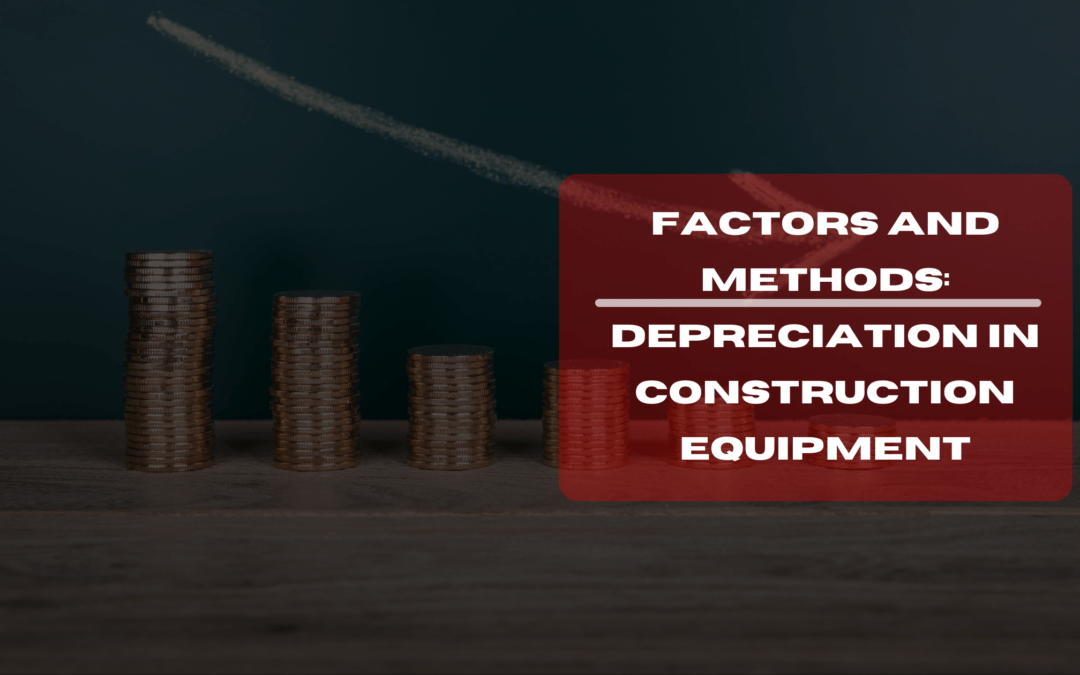Factors and Methods of Depreciation in Construction Equipment
In the world of construction, equipment is the unsung hero, powering the creation of infrastructure, buildings, and landmarks. However, as these mighty machines perform their duties day in and day out, they undergo a natural process known as depreciation. Depreciation is a crucial concept in construction equipment management and financial accounting, affecting a company’s balance sheet and decision-making processes. In this article, we will delve into the intricacies of depreciation, exploring what it is, why it happens, and the different methods used to calculate it.
Table of Contents
Defining Depreciation
Depreciation refers to the gradual decrease in the value of an asset over its useful life. In the context of construction equipment, it represents the diminishing worth of machinery as it experiences wear and tear, obsolescence, and the passage of time. Depreciation is an accounting method used to accurately reflect an asset’s declining value on a company’s financial statements.
The Factors Behind Equipment Depreciation
Several factors contribute to the depreciation of construction equipment. Understanding these factors is essential for effective equipment management:
1. Physical Wear and Tear
Why it matters: Construction equipment operates in demanding environments, often exposed to heavy loads, vibrations, and harsh weather conditions. The physical wear and tear resulting from these conditions lead to a gradual deterioration of equipment components, affecting its performance and value.
Takeaway: Regular maintenance and inspections are crucial to mitigate the effects of wear and tear and extend equipment lifespan.
2. Technological Obsolescence
Why it matters: The construction industry continually evolves with advancements in technology. Newer equipment models often come with improved efficiency, safety features, and environmental compliance. As technology progresses, older equipment may become outdated and less competitive.
Takeaway: Staying updated with technological advancements and periodically assessing equipment for obsolescence can help in managing depreciation.
3. Market Demand and Supply
Why it matters: The resale value of used construction equipment is influenced by market dynamics. Oversupply of specific equipment types or reduced demand can lead to lower prices in the resale market, contributing to depreciation.
Takeaway: Keeping an eye on market trends and demand for specific equipment can aid in decision-making regarding equipment acquisition and disposal.
4. Maintenance Costs
Why it matters: Neglecting maintenance or failing to address issues promptly can result in higher repair costs. Inadequate maintenance practices can lead to more extensive damage, accelerating depreciation.
Takeaway: Implementing a proactive maintenance schedule can help control costs and minimize the impact of depreciation.
5. Usage Intensity
Why it matters: Equipment subjected to heavy and continuous use is more likely to experience faster depreciation. High usage leads to increased wear on critical components, shortening their lifespan.
Takeaway: Monitoring equipment usage patterns and ensuring that equipment is allocated efficiently can help extend its lifespan.
6. Equipment Age
Why it matters: Older equipment tends to depreciate faster than newer models. The wear and tear accumulated over the years, combined with the lack of modern features, contribute to reduced value.
Takeaway: Assessing equipment age and planning for timely replacements or upgrades is essential for managing depreciation.
Different Methods for Calculating Depreciation
Several methods are used to calculate depreciation, each with its own advantages and implications. Here are some common depreciation calculation methods:
1. Straight-Line Depreciation
How it works: This method spreads the depreciation expense evenly over the asset’s useful life. It is simple to calculate and provides a steady and predictable expense pattern.
Use case: Straight-line depreciation is suitable for assets with a relatively uniform rate of wear and tear.
2. Declining Balance Depreciation
How it works: Declining balance depreciation applies a higher depreciation expense in the early years of an asset’s life. It reflects the higher maintenance and repair costs typically associated with older equipment.
Use case: This method is suitable when equipment tends to require more maintenance as it ages.
3. Units of Production Depreciation
How it works: Depreciation is calculated based on the actual usage or production output of the equipment. The more the equipment is used, the higher the depreciation expense.
Use case: Units of production depreciation is ideal for equipment where usage varies significantly.
4. Sum-of-the-Years-Digits Depreciation
How it works: This method accelerates depreciation by assigning higher expenses in the earlier years of an asset’s life. It provides a middle ground between straight-line and declining balance depreciation.
Use case: Sum-of-the-years-digits depreciation suits assets that experience moderate wear and tear.
5. Double Declining Balance Depreciation
How it works: A variation of declining balance depreciation, this method doubles the rate of depreciation in comparison to the declining balance method.
Use case: It is used for assets that experience rapid wear and tear, especially in their early years.
6. MACRS (Modified Accelerated Cost Recovery System)
How it works: MACRS is a tax-related depreciation method used in the United States. It assigns specific depreciation rates based on asset types and their useful lives.
Use case: MACRS is primarily used for tax purposes and is specific to U.S. tax regulations.
In Conclusion
Depreciation is an inherent aspect of owning and managing construction equipment. It accounts for the natural wear and tear, technological advancements, and market fluctuations that equipment undergoes over time. By understanding the factors contributing to depreciation and selecting appropriate depreciation calculation methods, construction professionals can make informed decisions about equipment acquisition, maintenance, and replacement.
Effective depreciation management not only ensures accurate financial reporting but also contributes to efficient equipment utilization and cost control in the construction industry. In this ever-evolving field, staying informed and proactive is the key to maximizing the value and longevity of construction equipment.
“The best way to predict your future is to create it.” – Abraham Lincoln
Investing in proper equipment management and depreciation strategies is how construction professionals shape a successful future in this dynamic industry.

